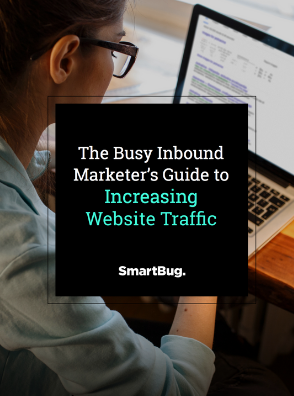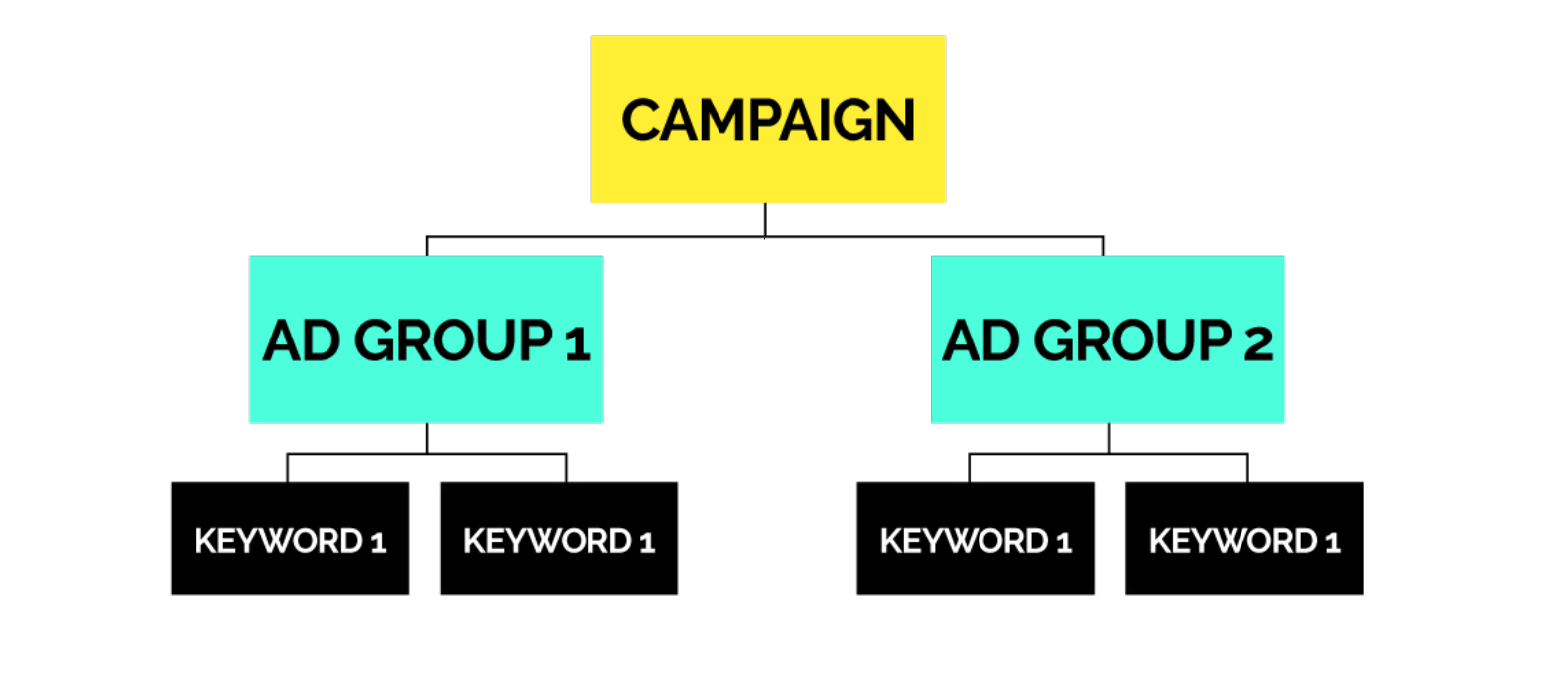
The Busy Inbound Marketer’s Guide to Increasing Website Traffic
You’ve read inbound marketing articles on traffic growth that include terms such as keywords, search engine optimization (SEO), blogging, pay-per-click (PPC), press or news releases, link building, and social sharing. But, how can you implement each of these correctly to successfully grow the traffic on your website?
Save this PDF to come back to in the future
You can download this guide as a PDF using the form here, or you can keep reading about the five core traffic channels you need to keep your eye on, actionable tactics to help you drive traffic for each channel, and preparing for long-term traffic growth.

Chapters
The 5 Core Traffic Channels
How to Grow Organic Traffic
How to Grow Direct Traffic
How to Grow Referral Traffic
How to Grow Paid Traffic
How to Grow Social Traffic
The 5 Core Traffic Channels

Organic Traffic
Simply explained, organic traffic comes from search engines like Google, Bing, and Yahoo. “Organic” implies that visitors did not click on a paid campaign or find you from any other channels. Rather, they searched for a specific term, or keyword phrase, in a search engine and one of your site’s pages was found. They clicked on the link and ended up on your website. Rather, they searched for a specific term, or keyword phrase, in a search engine and one of your site’s pages was found.
Why It's Important
Organic traffic drives qualified traffic to your website for free. Not only will spending time growing your organic traffic be important for increasing traffic, but it will also help you stay on budget.
Direct Traffic
Direct traffic is acquired when a visitor types in your website address, or URL, directly into the browser.
Why It’s Important
Growing direct traffic ensures that your brand is gaining awareness among your prospects and leads. It’s also the least affected by factors out of your control, such as competitive keywords. Direct traffic leads are quite a bit warmer than other kinds of leads, as well.
Referral Traffic
Referral traffic is defined as traffic that came to your site via direct links on other websites excluding search engines.
Why It’s Important
Referral traffic helps you improve your overall authority on the web. The more authoritative the website linking back to you, the more your “page rank” increases in Google’s eyes. It also provides a steady source of traffic beyond direct and organic traffic.
Typically, the lead referred to your site is of high quality, which in turn can impact your visit-to-lead and lead-to customer conversions.
Paid Traffic
When you buy ad space on Google or Bing and you connect your website to the advertisements, all traffic that comes through the ads is considered paid traffic. You can also have paid traffic from other sites like yellowpages.com or banner ads on industry-related websites.
Additionally, paid social ads are becoming increasingly popular given their ability to more directly target the users being advertised to.
Why It’s Important
Incorporating paid traffic, or pay-per-click (PPC) campaigns, into your strategy can help you quickly acquire traffic, especially when you don’t already have a good base. It also allows you to target keywords that you wouldn’t otherwise be able to rank for, or with paid social campaigns, allows your reach to grow at a faster rate.
Social Traffic
Social traffic is defined as visitors who come to your website through social media channels such as Facebook, LinkedIn, and Twitter.
Why It’s Important
Gaining buzz on social media is growing in importance to search engines. It also shows you where your key audience members lie. Additionally, social media allows you to share content pieces more than once as the audience of your pages is ever-changing. Some of your best leads can come from social media, too.
How to Grow Organic Traffic

5 Steps to Growing Direct Organic Traffic
Define Long Tail Keywords
Long tail keywords, or keyword phrases, consist of three or more words and target a more specific topic than broad keywords. While long tail keywords have fewer monthly searches, they are much less competitive, making them easier to rank for.
If you’re using HubSpot, choose keywords that have a difficulty of less than 60 with monthly searches over 100. Stay away from branded keywords (such as your company name); your website is already optimized for that. Pick between 10 and 20 keywords that are your best opportunities and that you’d like to rank for. Note them in a campaign in HubSpot or keep in a list on Notepad to refer to later. For example “shoes” is broad, while “red running shoes” is long tail.
Optimize Your Website
Once you’ve chosen your optimal long tail keywords, you can begin to optimize your website with on-page SEO tactics. When you first start doing this, be wary of going on SEO tangents. There are so many people giving advice that getting off-track is easy to do. Start with the basics, optimize, and then refine with more advanced techniques later.
Here are some quick tips for optimizing your site.
- Pick one target keyword for every site page (excluding the home page; you can do more keywords there).
- Start at the top of your browser and work your way down. Is the target keyword in the page title? URL? H1 title? Used a couple of times in the text?
- Add alt-text to your images.
- Make sure content is relevant to the keyword and reads normally. You should not stuff keywords within your page’s text.
- Add meta descriptions for each page.
- Ensure you include internal links, or links that connect your website’s pages, to each page.
- There are, of course, many ways to optimize a site. The above list should get you started.
Start Blogging with Keywords
By now you probably have a blog, which is great! Blogging is the most effective way to drive organic traffic to your website and also helps you obtain more monthly leads. If you haven’t started blogging, start today. Many companies that blog still haven’t mastered the concept, though. For example, a lot of companies write about company news, product launches, or other things that ultimately will not get you found. Instead of writing about internal happenings and using it to promote your products or service, write about industry topics, advice, and tips. Your blog should be used to capture what your leads are searching for.
Follow these tips to start blogging correctly:
- Optimize your blog posts by including a keyword in each title. For example, if you want to rank for “red running shoes” you might create a blog “titled 13 Tips for Picking the Best Red Running Shoes.” (Note: Your blogging terms will be typically different from your on-page SEO terms. Since you’ll be talking about industry topics, the blog keywords will be more detailed and specific to persona pain points, rather than broad offerings. For example, you might have a page on your shoe website that you’re optimizing for “formal wear,” while a blog relating to that would be optimized for “best prom shoes.” Both types should follow the same guidelines for difficulty and monthly searches.)
- Blog regularly. If you’re only posting once a month, once every two weeks, or not at all, you’ll never move up or get found Google. Each blog post is a new page indexed by search engines. So, if you blog three times per week, that’s 12 more opportunities to be found by prospects and leads. Bottom line: Set a schedule and stick to it.
- Know your facts. Blogging can boost your traffic exponentially when done often enough. For example, blogging three to four times per week can up your traffic gains by 13 percent month over month.
- Follow best practices. If you’re not sure what those are, don’t worry. There are several blog posts that lay each of the best practices out simply. Things like including a related image, making sure your on-page SEO tactics are included in each post, and having a call-to-action at the bottom will boost your overall marketing performance, including traffic gains.
Create More Optimized Content
Content is the only way you’re going to get found more often on Google. This includes the blogging spoken about in the last point. You should be creating as much content as possible. As mentioned previously, everything you create, including images, gets indexed by Google and allows you to be found. If you’re not creating content, the likelihood of driving more organic traffic goes down considerably. Additionally, any time you create an e-book, landing page, call-to-action, images, and literally anything else, you should keep your keywords in mind. Google now shows PDFs in the search results, for example. Having a keyword in your e-book title can help you get found for that offer more easily.
Create a Repeatable Process
One of the biggest challenges for marketers is getting organized. Here is the easiest way to organize yourself for maximize organic traffic growth:
Distinguish on-page SEO from blogging keywords.
Develop blogging keywords by campaign. To help make narrowing down the “pain point” keywords easier, look at what e-book or other content pieces you’re launching or promoting that month. Do your research around those pain points. Blog and promote the content with a call-to-action at the bottom of the post.
Set up a blogging schedule. If you plan to blog three times a week, decide on the days to publish. It also helps to block off time when you can write in batches, then schedule out the posts ahead of time.
If you don’t have a full team that you can utilize, consider working with an agency. Inbound marketing agencies like SmartBug Media can help you prioritize your traffic growth plan, generate multiple weekly blogs, and accelerate your results.
To help make narrowing down the “pain point” keywords easier, look at what e-book or other content pieces you’re launching or promoting that month.
Resources
3 Tools to Optimize Your Old Content to Build More Organic Search
Read MoreHow to Grow Direct Traffic

Consider Your Traditional Marketing Efforts
Most marketing teams will see a spike in direct traffic when they go to a trade show, send out a print mailer, or release any other kind of advertisement. The reason is because this kind of marketing material or campaign typically prints your website address. Thus, recipients or attendees type the URL into their browser directly.
Tips for Growing Qualified Direct Traffic
Two problems marketers face with traditional marketing efforts are capturing information on print ads and learning about qualified traffic driven by those ads. This can be addressed by doing the following:
- Creating tracking URLs. Sites like bitly.com and HubSpot make creating tracking URLs a breeze. Tracking URL builders work by adding a token to the end of your normal URL. The token allows analytic tools to track where visitors are coming from. Need to know how well your mailer performed? Use a tracking URL. What about trade show participants? Use a tracking URL on your booth. Make sure to use a different tracking URL for each campaign piece so that you can divide the results easily.
- On your print campaigns, link to pages related to your campaign rather than simply your home page. If you’re trying to sell more red shoes, create a website page about red shoes, make a tracking URL for the red shoes page, and use that in your campaign. This will help anyone who is qualified to buy red shoes get to the end result sooner, without having to hunt.
Tracking URL builders work by adding a token to the end of your normal URL.
- Go a step further and link your ads to a landing page. A landing page is any page that includes a form where lead intelligence can be captured. Create a red shoes landing page that encourages your traffic to convert into a lead by filling out the form in exchange for something else. Maybe it’s a red shoe style guide or a coupon for for 10 percent off their next pair of red shoes. The goal is to get their email address so you can contact them again. As always, create a tracking URL for this landing page, too.
Bottom line: If you’re only driving traffic to your home page, you’re missing out on traffic insights and lead conversion opportunities from direct traffic.
How to Grow Referral Traffic

Ideas for Growing Referral Traffic
Create Remarkable Content
You’ve heard this advice time and time again, but it remains true: Content is important, and content that people love, and want to share, is king. By creating content that is happy, controversial, inspiring, informative, thought-provoking, and most important, targets your readers, many of them will share your content on social channels or refer back to you from their own blog. It’s the one true way to get more referrals.
Content that you should create includes, but is not limited to:
- E-books
- Blog posts
- SlideShare presentations
- News releases
- Infographics
- Webinars
- Video demos
- Video tips
- And any other piece of content you can think of
Share Your Own Content
One mistake many marketers make is sitting back and hoping people stumble upon their remarkable content. Stop doing that. Share, share, share! You need to tell people about this awesome content for them to hear about it.
Sure, over time your SEO strategy will kick in, but what about the immediate need for traffic? Build your audience and share on the social media channels where your leads are hanging out, such as Twitter, Facebook, LinkedIn, Google+, SlideShare, and so many more.
Optimize for Future Success
It’s true, on-Page SEO is a necessary component for driving traffic to your website, including referral traffic. By including keyword-focused blog titles that catch the reader’s attention, users are more likely to click and more likely to share. The more optimized content you have, the greater your chances are of that content being found. So, please, do not leave search engine optimization by the wayside. Include it in all you do and that traffic will come.
Included in this strategy are meta descriptions. While they don’t help you rank higher and are often forgotten, make sure you include them in your strategy. Why? Well, for starters, it is another way to grab the reader’s attention. Google has been bolding keywords in the meta descriptions, as of late, and the more enticing the description is, the greater the likelihood that someone will click on your link, love your remarkable content, and share it.
To conclude, remember that you can’t control referral traffic. You have to simply entice and encourage readers to share your remarkable content. Then, let Google handle the rest.
The more optimized content you have, the greater your chances are of that content being found.
How to Grow Paid Traffic

4 Tips for Growing Paid Traffic
Understand the Structure of Campaigns
When you create a PPC campaign, make sure you understand how the system is structured. Many marketers believe keywords are all you need to understand, but in actuality, there is a lot more that goes into creating PPC campaigns. Keywords are the lowest level of the campaign structure. Keywords, when grouped together, are called “Ad Groups”, and the Ad Groups make up the sum of the campaign. To help you understand, here is a handy chart to follow:

Understanding this structure is important, particularly when you are running multiple campaigns. By creating Ad Groups and specifying which keywords go where you can also align budgets and conversion rate tracking accordingly.
Find and Target the Right Keywords
As you know, choosing keywords for organic is important. The same rule applies to PPC campaigns. If you’re not targeting the right keywords, you will never gain the kind of traffic you need to convert visitors into leads.
In order to choose the right keywords, you need to do the following:
- Create a list of keywords that are grouped as generic, branded, related, and competitor terms.
- Make the terms in your list contain 3 or more words so that they become “long tail.”
- Use the Google Keyword Tool to find words in your list that have high search volume with low competition.
- Organize your final keywords into campaigns.
- Remember to include negative keyword terms, or keywords that you do not want to show up for. Once you have your keywords set up, you can start adding your landing pages to the ads and focusing on the quality score mentioned above.
If you’re not targeting the right keywords, you will never gain the kind of traffic you need to convert visitors into leads.
Write Ads That Have a High Quality Score
The amount you bid for ad placement plays a significant role in determining whether and where your ad gets placed. However, it is not the only thing that is taken into consideration when working with PPC campaigns. The relevancy of the ad to searchers’ queries matters as well. While Google wants to give businesses what they want, the ultimate goal is to make users happy, and thus quality score was born. Google gives each ad a “quality score,” which means an algorithm evaluates how relevant your ad and landing page are in regard to the search term you’ve chosen.
Quality score ranks ads from one to 10 with 10 being the best. The more relevant your ad, the higher the score and the more likely you are to get placed and shown. You get the idea. Another benefit to quality score is that if you bid lower, but your quality score is higher than a competitor, your ad will still be placed above it. Sweet!
Pro Tip
Remember to link your ads to landing pages with forms on them. If you don’t, you will receive traffic but no leads. The goal is to prove the ROI of your efforts, so always, always, always link to a landing page with an offer (like an e-book, white paper, guide, or specific consultation) before making your ads live.
Set a Budget and Analyze Performance
PPC budgets are debated all the time. How much do you need to spend in reality? There isn’t one answer that works for every company. In truth, the more you spend on PPC, the more traffic you’re going to get. However, when deciding how much of your budget should be allocated to your PPC campaigns, ask yourself these questions:
Are the keywords I’m trying to target attainable through organic search? If so, you should create blog content and use SEO tactics instead of buying that traffic.
- Are the keywords I’m targeting going to bring me qualified traffic? If not, don’t bother spending money on them. The
goal of more traffic is to increase your lead conversions, not collect every visitor on the internet. Not qualified, not worth
your money. - Am I already ranking on the first page in Google for some of these keywords? If you are already ranking on the first page in Google for the keywords you’re purchasing, it’s a waste of money. Do not spend money on something you don’t need.
If you’re going to spend money on PPC, make sure it is actually worth your while and continue to analyze its performance.
You should note that if you’re creating blog posts and doing PPC simultaneously (which you should do), some of your currently paid-for keywords will start to grow in organic search ranks.
Once that happens, kill the PPC campaign for that word and brag about how you’ve saved your company money without sacrificing the number of leads or lead quality.
In truth, the more you spend on PPC, the more traffic you’re going to get.
Resources
How to Grow Social Traffic

3 Steps for Increasing Social Traffic
Add your website URL to all profiles
First things first. If your website URL is not in the profiles of your social networks, you are missing a huge opportunity to promote your brand. Include it in the bio or about sections on all networks!
Always share your content. No exceptions.
Are you blogging? Share it on social. Have you written an e-book, guide, or white paper? Share it on social. Have a webinar coming up or just added one to YouTube? Share that link on social! By sharing your content, more people will see it and thus more traffic will come to your site. On networks like Twitter, you can share your content a few times a week, and if large enough, even a few times a day. However, don’t overdo it and spam people. Share politely, but share everything.
Monitor and engage with your audience.
Now that you’re sharing your content, you can start to engage with other people within your networks through comments, retweets, favorite tweets, shares, and so on. This step is important to improve how large your reach is. The more retweets you receive, for example, the more people will see your post.
A few tips for engaging with your audience:
- Use hashtags. Hashtags are used to categorize your tweets. For example for this guide we might promote it with the
hashtag #inboundmarketing. Hashtags are searchable and let users know what your post is about. This is true for Twitter, Instagram, and Facebook. - Mention influencers. Influencers are people who have a lot of clout in your industry. For example, we might mention
Brian Halligan, the founder of HubSpot, when we tweet about inbound marketing. We might also mention HubSpot itself. An example tweet to promote this guide would be: “In our newest guide marketers learn how using @HubSpot can help them grow traffic with #inboundmarketing.” You can
also tag influencers on Facebook by following their page and typing their name into the status update. - Use photos. Studies have shown that Twitter posts with images receive two times the amount of engagement of those without. Just like on Facebook, images are important
for communicating your message quickly and effectively. Use them. - Post when your audience is online. This will take some experimenting on your part. Try different times on all social media channels and monitor which posts get the most clicks, make note of the time, and then repeat the process.
- Tailor your message to the audience. The truth is that our personas use all different kinds of social media tools and not all of those tools are used for work. Some use LinkedIn to find industry information, while others hunt down information on Twitter. Others capture their news on Facebook or Google+. It’s important that you find where your audience is and what works for them on each network. Tailor your posts to the network and the persona to see the highest influx of traffic.
Social media can be a time-consuming tool. It is best to figure out your most profitable tool and use that most often. Tools like HubSpot’s social media publisher can also help you cut time and improve productivity.
Download the Busy Marketer's Guide to Increasing Website Traffic!
Simply fill out this form to receive a PDF version of our guide.




